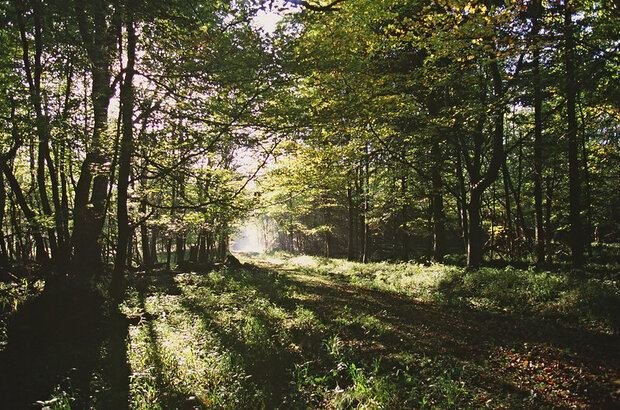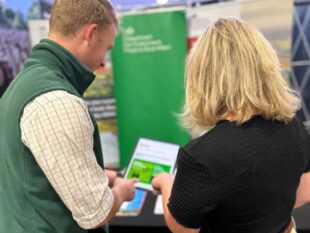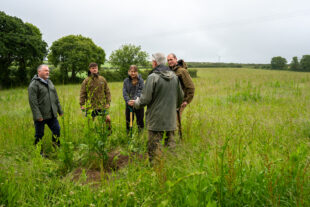
The England Woodland Creation Offer (EWCO) is one of a number of ongoing payments that can support farmers to manage their land in an environmentally sustainable way while continuing to produce food.
We're offering the opportunity to create woodland of various types and sizes in a flexible way that works for both land managers and farmers.
We are inviting eligible farmers and land managers to apply for a share of £25 million available this financial year to support woodland creation in England.
Land areas as small as 1 hectare and up can enter a EWCO agreement to access this funding.
There is no reason to delay planting trees on your land.
The England Woodland Creation Offer will, from 2025, become part of Local Nature Recovery – one of our new environmental land management schemes.
The tree planting offer within Local Nature Recovery, and the approach to payment rates, will largely mirror those of the England Woodland Creation Offer, allowing for some changes in response to user feedback.
You could get a one-off payment of £8,500 per hectare, followed by annual maintenance payments of £300 per hectare for 10 years.
Woodland and food production work hand-in-hand
Planting trees doesn’t have to come at the expense of food production. Trees grow well in less productive soils. Well-designed and well-managed woodlands can also support the foundations of food production: healthy soil, cleaner water, and biodiverse ecosystems.
Trees and woodlands can help farm businesses become more diverse, economically and ecologically resilient. They can provide new streams of income from timber, carbon units, and through recreation.
That’s why we are investing £750 million of the Nature for Climate Fund into planting, expanding, and managing woodlands over this parliament. The overwhelming majority of woodland creation in England is on lower-grade agricultural land (3b or below). Forestry Commission are required to consult the public on any new woodland creation proposal paid for by grant, or which is significant enough to require an Environmental Impact Assessment, which would include any large or commercial project.
Planting more trees and woodlands is a key part of the government’s plan to level up the rural economy and deliver for nature, people and jobs. Not only do trees absorb and lock up carbon, helping to tackle climate change, but the right tree in the right place can improve water quality, reduce flood risks, clean the air, improve soil health and reduce nutrient loss from surface run off, provide shelter for livestock in adverse weather, and provide green spaces for people to enjoy.
Growing more timber at home will reduce our dependence on imports, and help to increase the use of timber – a low cost, renewable material - in construction.
Greater reward and recognition
Trees are a precious natural asset and central to the fight against climate change. EWCO also offers additional incentives for woodland that will help to mitigate climate change, deliver nature recovery and provide wider environmental and social benefits.
In addition to covering the standard costs of tree planting and annual maintenance, EWCO will pay more for tree planting that can benefit society and contribute towards ecosystem services.
This means more financial reward for planting and managing trees, in particular:
- new native woodland, especially where this extends existing native woodland
- woodland created alongside watercourses that lack shade
- where woodland can provide public access.
The additional contributions are optional, but they recognise the benefits woodland can provide for people and wildlife, and they can even be combined as part of an application.
You could receive:
- £500 per hectare for woodlands that are close to where people live
- up to £2,200 per hectare for providing access to woodlands for the public to enjoy
- £500 per hectare for woodlands that help reduce the risk of flooding
- up to £2,000 per hectare for woodlands along riverbanks that improve water quality and habitats
- up to £2,800 per hectare for woodlands that restore nature and species.
Eligibility
Anyone with management control over eligible land can apply for EWCO. Land managers can also come together and make joint applications across multiple land holdings.
Check your eligibility on GOV.UK.
The applications process
You can submit an application at any time of the year. There is no deadline. You can find a step-by-step guide on GOV.UK.
EWCO is a criteria-based competitive scheme, with funding offered on a first come, first served basis. Applicants need to score their own applications which the Forestry Commission will then review. The Forestry Commission will offer agreements to applicants whose proposal score meet or exceed a threshold score.
The threshold score set is based on the available budget and is reviewed every 3 months. The most up-to-date score will be shown on GOV.UK. It is currently set at 10 points.
If you are considering making an application to EWCO, we recommend that you contact your local Woodland Creation Officer as early as possible.
After 2025
As mentioned above, the England Woodland Creation Offer will eventually become part of Local Nature Recovery. The majority of new applications for woodland creation payments from 2025 will be made through Local Nature Recovery.
We expect existing England Woodland Creation Offer agreement holders to have the opportunity to transition their maintenance payments into Local Nature Recovery from 2026.
If you have any questions about the scheme, leave a comment below.



10 comments
Comment by Dr A T Chamberlain posted on
Heat stress in dairy cattle is a growing problem and particularly an issue in the current weather. 75% of farms graze their animals in the summer and heat stress can be a bigger problem at grass than when housed. Water and shade are the two key mitigations. Water can be supplied from the farm but shade is best provided by trees. Our modelling suggests 8-10% of the grazed area should be in shade and this requires sizeable trees (over 17m) on all field boundaries. Will such planting be supported by these schemes?
Comment by The Team posted on
Thank you for visiting the blog and for leaving a comment, Dr. Chamberlain.
Heat stress is a big issue for dairy cows - we know that it starts to have an impact at wet bulb temperatures above 20 degrees centigrade.
We're interested to learn more about your modelling - in particular the field size and the spacing of the trees along the field boundary. Are you able to share links to your work? Or, if you're happy for us to, we can pass on your details to our colleagues in co-design and policy who would love to learn more.
We'll share a link to another scheme through which we're supporting famers to keep animal health and welfare standards high: https://www.gov.uk/government/publications/animal-health-and-welfare-pathway/animal-health-and-welfare-pathway
You might've seen that Defra recently updated its guidance on keeping farm animals in hot weather: https://www.gov.uk/guidance/keeping-farm-animals-and-horses-in-extreme-weather
Best wishes,
The Team
Comment by Tom Chamberlain posted on
Thank you for your reply. Two pieces of my recent work portfolio have encouraged me to consider shade provision for grazing animals:
1. I have just completed an Innovate UK funded project that looked to increase grass intakes and hence milk production in grazing cows. This has given me considerable experience in assessing grassland productivity and allocating daily allowances on modern, intensively managed dairy farms.
2. I am running an industry funded project to assess and publicise heat stress problems on English dairy farms. We currently have monitoring devices on ten dairy farms which report conditions inside and outside in real time to the internet (www.dchs.info). This has shown that conditions when grazing can actually be worse than in housed conditions – full-sun temperatures can reach 44’C. Shade provision is one of the few applicable mitigation strategies.
Whist promoting our heat stress results through social media I have been communicating with Emily Roberts who is the senior project manager for the Tree Strategy and 2050 Tree Planting Programme with Hampshire County Council Countryside Service and we have been discussing using trees to provide shade in grazing paddocks.
Having met with Emily last month to discuss tree planting I have created some simple spreadsheet models looking at grazing areas required and shade requirements. Although I have various Excel models and documents on my findings these are not, at present, in a finished report that I can link you to. However it would be very useful to have a teleconference or similar with your colleagues and to include Emily Roberts is such a meeting.
Thank you for your link to the Animal Health and Welfare Pathway. I note the first ‘strand’ entitled ‘Financially rewarding farmers who deliver public goods’. Planting shade trees would improve animal welfare, provide an often requested public good and help with carbon sequestration. Such planting would be individual trees or ribbons of trees along fence lines which I understand are not supported in current grant funding. Would funding be available from the pathway? This would also link to the fifth health and welfare priority for cattle. I note you give a national cost of BVD to the industry of £14-36 million. By way of comparison we have calculated the national losses from heat stress to be approximately £144 million per annum with £72 million due to milk yield losses alone with associated increases in GHG production.
Comment by Sir Richard Dalton posted on
Please simplify and accelerate the currently burdensome and over-detailed EWCO application process. For our 50 hectare application, it's been like jewellery-making, with changing rules during the application period. It has been harder than getting planning permission in a conservation area.
Please publish long term production income estimates, or ranges, over 30-50 years to help farmers decide whether it's going to be good business: just plugging the short term, albeit excellent, grants doesn't cut it when considering which crops to plant.
Please introduce a two tier system, so woods below a certain size can be grant funded with reduced prior vetting than for large schemes; eg by requiring commitments to good practise over 15 years and then spot-checking. This would help reduce pressure on FC's over-stretched teams.
Comment by The Team posted on
Hello Richard,
Thanks for visiting our blog. We sent your comment to colleagues in the Forestry Commission, who wish to thank you for taking the time to give your feedback.
In reply, they said they will continue to improve EWCO in response to user feedback while trying to retain stability. They added that they are always looking for opportunities to streamline the application process, making sure that they collect sufficient information to ensure public money is spent appropriately across England.
They will continue to review their processes as they transition EWCO into Local Nature Recovery. They have noted your suggestion for long term production income estimates.
If you'd like to discuss your application with the team, email ewco@forestrycommission.gov.uk
Best wishes,
The Team
Comment by Richard Dalton posted on
Thank you very much for writing. Much appreciated. Glad you are working closely with FC and all stakeholders.
Good luck.
Richard
Comment by Jon Kempson posted on
Can you explain the rationale behind planting trees to completely cover large areas of class 1 agricultural land?
Is this really the idea of this policy at a time of severe pressure on the UKs food security?
Comment by Sarah Stewart posted on
Hi Jon,
Can you let me know where you've read this?
Best wishes,
Sarah
Comment by Jon Kempson posted on
Hi Sarah
Rather than read this, this is actually a real life, published proposal by Central Bedfordshire Council for 30ha of class 1 BMV land at Beeston, Bedfordshire.
The scheme is proposed by CBC and the Forest of Marston Vale who are administering the DEFRA funding (their words not mine)
This 30ha has enjoyed gov payments to the last tenant farmer to establish habitat for targeted species over the last 10 years by adapting methods of food production. This has been very successful with a proliferation of diverse species. Money well spent, well intentioned and well implemented.
Naturally the red list species that have been encouraged are not woodland species so the last 10 years effort (& money) will have been a complete waste.
Surely, as stated by yourselves, tree planting should be encouraged to be primarily carried out on a poorer grade of soil especially if that planting will also add to flooding prevention and an increase in biodiversity?
Comment by Sarah Stewart posted on
Hi Jon,
Thank you for sharing the extra detail, it’s helpful to have context.
I spoke to the Marston Vale team. They explained that the land in question is owned by Central Bedfordshire Council and is part of a much larger estate. The council decided to make this land available to expand the Marston Vale Community Forest, which will create new community woodland. Marston Vale Community Forest is using funding Defra has made available to England’s Community Forests from the Nature for Climate Fund. This isn’t a Future Farming and Countryside Programme scheme, so colleagues in the Forest of Marston Vale are best placed to pick up the discussion on this specific case. https://www.marstonvale.org/contact
A degree of land-use change is necessary if we are to achieve our targets to plant 10,000 hectares of trees per year.
As a result, you're right, we are encouraging people to consider switching areas of low productivity and unprofitable land to other land uses, including making space for tree and scrub planting. However, such a change would take place on a relatively small area of the 9.3 million hectares of farmland in England.
Colleagues working on the England Woodland Creation Offer (my team's tree planting scheme) explained that only a tiny proportion of woodland creation applications are on mapped grade 1 land and will have been designed and planted by the landowner to meet their own specific objectives, for example protecting water courses, providing areas of habitat or for screening.
Ultimately it is down to land managers to consider how they want to manage their land, but it is rare to see planting proposals brought forward on our best and most versatile agricultural land (grades 1, 2, 3a) – this land is usually too valuable for land managers to choose to plant.
The Forestry Commission also considers the impacts of planting through an Environmental Impact Assessment (EIA), this includes considering the impact on habitats and food production. If the impact were to be significant, a detailed assessment would then be required, and a proposal might not be approved. The sensitivity mapping that supports the EIA regulations classifies our best and most versatile agricultural land as more sensitive to tree planting.
Food production is the primary purpose of farming and always will be. We’re not asking anyone to choose between food and the environment: our view is that food production, farm businesses and the environment can and must go hand in hand. For many farmers, improving the environment will support food production. For example, good soil health is in turn good for water quality, and improves climate resilience, biodiversity, and food production.
In the case where land use change is needed, improvements in productivity in other areas will offset to some extent any reduction in food production. Balancing and integrating food production with our environmental land management will support efficient and sustainable land use without offshoring harms associated with lower production standards.
Best wishes,
Sarah